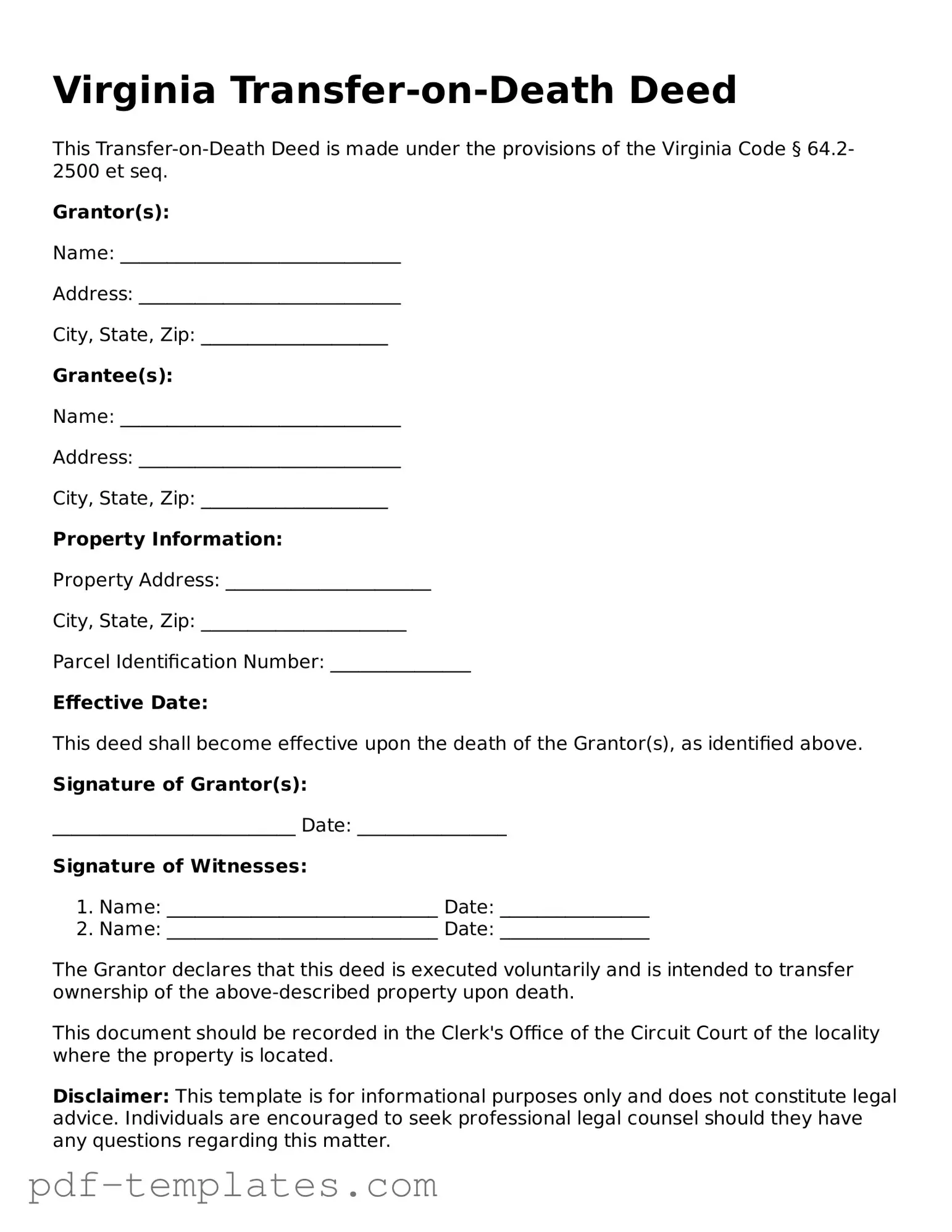The Virginia Transfer-on-Death Deed (TOD) is a unique estate planning tool that allows property owners to transfer their real estate to beneficiaries without going through probate. This deed is similar to a Living Trust, which also facilitates the transfer of assets upon the owner’s death. A Living Trust holds property during the owner’s lifetime and designates beneficiaries to receive the property after death. Both documents aim to simplify the transfer process and avoid the lengthy probate procedure, but a Living Trust can encompass various types of assets beyond real estate.
Another document akin to the TOD is the Will. A Will outlines how a person wishes their assets to be distributed after death. While both documents serve the purpose of transferring property, a Will typically requires probate, which can be time-consuming and costly. In contrast, the TOD deed allows for a more streamlined transfer of property directly to the beneficiary, bypassing the probate process altogether.
The Durable Power of Attorney (DPOA) also shares similarities with the TOD deed. While a TOD deed specifies how property is transferred after death, a DPOA allows an individual to designate someone to manage their financial affairs while they are still alive but incapacitated. Both documents are essential for estate planning, ensuring that a person’s wishes are respected, whether they are alive or deceased.
A Joint Tenancy Agreement is another document that resembles the TOD deed. In a Joint Tenancy, two or more individuals hold title to a property together, and upon the death of one tenant, the property automatically transfers to the surviving tenant(s). Like the TOD deed, this arrangement avoids probate and facilitates a smooth transition of ownership. However, unlike the TOD deed, joint tenancy involves shared ownership during the owner’s lifetime.
The Life Estate Deed is similar in that it allows an individual to retain certain rights to a property while designating a beneficiary to receive the property upon their death. This arrangement provides the original owner with the ability to live in or use the property during their lifetime, while ensuring a clear transfer of ownership afterward. Both the Life Estate Deed and the TOD deed help avoid probate, but they differ in the rights retained by the original owner.
A Transfer-on-Death Registration (TODR) for securities is another comparable document. This registration allows individuals to name beneficiaries for their financial accounts, such as stocks or bonds. Similar to the TOD deed, the TODR facilitates the direct transfer of assets upon death without going through probate. Both documents reflect a growing trend toward simplifying the transfer of assets and providing clarity to beneficiaries.
The Beneficiary Designation form used for retirement accounts and insurance policies is another document that aligns with the TOD deed. This form allows individuals to name beneficiaries who will receive the proceeds of their accounts upon death. Like the TOD deed, this process bypasses probate, ensuring that beneficiaries receive their inheritance quickly and efficiently. Both documents emphasize the importance of clearly designating who will inherit assets.
The Quitclaim Deed can also be considered similar to the TOD deed. A Quitclaim Deed is used to transfer ownership of property without guaranteeing that the title is clear. While it is often used to transfer property between family members or in divorce situations, it does not provide the same automatic transfer upon death that the TOD deed offers. However, both documents facilitate property transfers, albeit in different contexts.
The Trader Joe's application form is a vital document for job seekers wishing to join this beloved grocery chain. It outlines necessary information about potential employees and provides an opportunity to showcase their unique skills and experience. Completing the form accurately can significantly increase the chances of landing a position at one of their stores. For more details, refer to the application here: https://documentonline.org/blank-trader-joe-s-application/.
Lastly, the Assignment of Interest document shares some characteristics with the TOD deed. This document allows an individual to assign their rights or interests in a property to another party. While an Assignment of Interest can be executed during a person’s lifetime, the TOD deed specifically designates a beneficiary to receive property upon the owner’s death. Both documents can simplify the transfer process, but they serve different purposes in estate planning.
